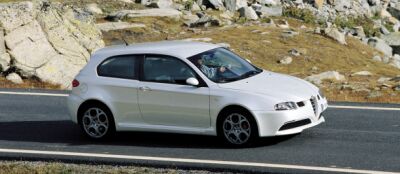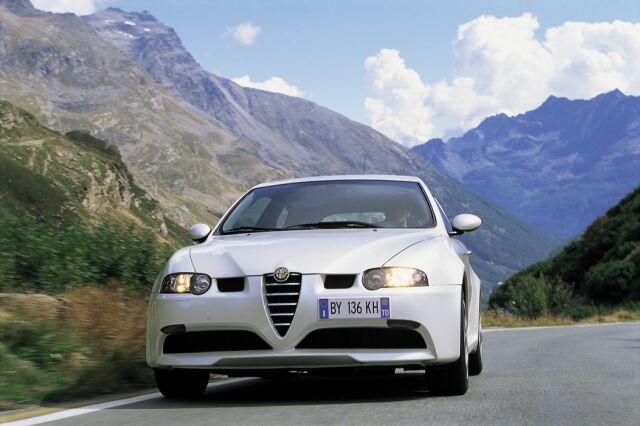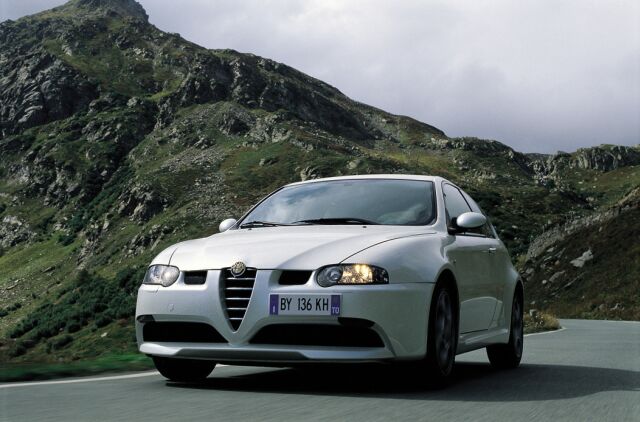| >>> styling
exterior
Alfa Romeo aimed to complement
the GTA with styling that conveys an idea of strength and sportiness in
a few brief but telling lines. This they planned to be achieved without
altering the car's original, stylish shape. Changes that affected the external
appearance had to be limited to parts affected by technical changes to
the chassis and mechanicals.
The outcome is the Alfa 147
GTA, an out and out sporty model that borrows the clean, spare design that
assured the basic model much success. The natural tension set up between
the rounded surfaces and ridges is resolved in an ideal balance. The design
also hints at historical brand motifs, albeit in a very modern and understated
way. For example, the bonnet is drawn out lengthways to suggest a mighty
engine capable of far from ordinary verve and alacrity. The tail tapers
when viewed from top or side to make the car look more slender and dynamic.
The Alfa 147 GTA has borrowed
all these exterior features from the basic model. The new model differs
in its broad wings that stand out at the front to accommodate the larger
17 inch wheels ( with 225/45 tyres ); in the black headlight ground that
adds to the air of sportiness and the foglights that have been shifted
toward the outside of the car to free the air intakes and allow the power
unit to be cooled more easily.
The resulting image is of
a strong, compact car with mastery of the road and a pronounced personality
of its own. This is also borne out by a beefy side view underscored by
a new moulding linking the two broad wings. New five-ringed wheels exclusive
to the GTA range add a clean, highly engineered feel ( spoked wheels more
typical of cars used for motorsport are optional ).
At the rear, the new version
features a larger bumper. This feature is hardly apparent from the side
but is apparent when the car is viewed from behind. The lower part of the
147 GTA's rear end looks completely different from the original model from
boot floor level downward. One reason is that the rear bumper contains
a big extractor that is visibly divided by the metal panels into one long
horizontal opening and two smaller side openings. The extractor serves
the aerodynamic function of carrying airflow from the front of the car
to the back of the car, i.e. of extracting the airflow. The final touch
is provided by two oval exhaust tailpipes in line with one of the brand's
classic styling cues.
Ten body colours are available
on the GTA, including the outstanding Nuvola White, an iridescent shade
exclusive to the model.
interior
In a car of great temperament,
the interior always revolves around the driver's cockpit. The Alfa 147
GTA is no exception, as you would expect from a car created for performance.
The GTA complements the basic Alfa 147 package with a few sporty styling
details exclusive to the version.
These include a brand-new
three-spoked steering wheel, gear lever with leather gaiter and surrounds
in Puma grey, a darker shade than that of other Alfa 147 versions. The
out and out sporty pedals include aluminium pedal covers and footrests
with rubber inserts and ergonomic shapes. These are complemented by a mat
in the central storage compartment made out of metalluro with rubber detailing.
The seats are sports-configured
and cloth trimmed. The model offers three exclusive colours: red, silver
and blue. Leather upholstery is also an option: this comes in one shade
( black ) or as a two-tone combination. The latter offer black leather
side bands while the central cushion and backrest insert may be in natural,
grey or blue as required by the customer. The seat design displays the
horizontal ridged design made famous by so many Italian sports cars of
the past. The front seats come with a built-in head-restraint and adjustable
seat. They are divided by an armrest with storage compartment. The rear
seat offers the same sports configuration but all the comfort of a true
five-seater.
The Alfa 147 GTA interiors
may also be distinguished from other model versions by other features.
The door panels, for example, come with cloth and leather inserts that
reflect the same motifs and colours as the central part of the seats. The
ceiling is grey-black, while the boot trim is completely black. The same
applies to the sun visors, courtesy light and pillars. One more distinctive
trait that has become a standard feature on the Alfa 147 GTA is a mat fastened
mechanically to the carpet. The sill plates come with a satinised metal
insert bearing the wording GTA in bright metal.
The control panel also displays
new features, with special gauges and a black background. The reading scales
also look different, while a screen on the multifunction display shows
engine oil temperature. |



